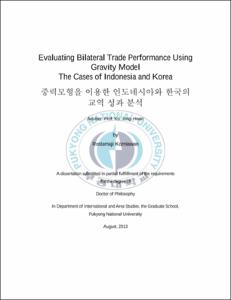중력모형을 이용한 인도네시아와 한국의 교역 성과 분석
- Abstract
- There is a notable increase in Korea’s and Indonesia’s exports and imports which indicates that bilateral trade flows are improving and should be evaluated to convince people that foreign trade is vital to economic development. From that evidence, this study attempts to evaluate Korea’s and Indonesia’s bilateral trade performance with the gravity model using annual data from 1995 to 2009. The evaluation emphasizes FDI as the notable variable to determine bilateral trade flows. Moreover, FTA and population, as the explanatory variables, function as the complementary variables. The analysis takes several steps to find feasible variables to explain bilateral trade flows. The findings reveal that 30 of 136 countries are better at explaining bilateral trade flows rather than 136 countries. Therefore, the results find that FDI in Korea and its trading partners significantly and positively affect Korea’s bilateral trade flows. On the other hand, FDI in Indonesia and its trading partners significantly, but negatively, affect Indonesia’s bilateral trade flows. The disparity of the results compared to the real condition implies some suitable policies for society, government, and the business sector, particularly in the case of trade and investment.
- Issued Date
- 2013
- Awarded Date
- 2013. 8
- Type
- Dissertation
- Publisher
- 부경대학교
- Affiliation
- 대학원
- Department
- 대학원 국제지역학과
- Advisor
- 고종환
- Table Of Contents
- CHAPTER 1 INTRODUCTION 1
CHAPTER 2 LITERATURE REVIEW 6
2.1 InternationalTrade 6
2.2 Exploring the Theory of the Relationship between Trade and Investment 8
2.3 Specification of the Gravity Model 12
2.4 Indonesia and Korea In Brief 14
CHAPTER 3 DISCUSSING TRADE POLICY IN INDONESIA AND KOREA 19
3.1 Trade Policy 19
3.1.1 Trade Policy in Korea 19
3.1.2 Trade Policy in Indonesia 23
3.2 The Pattern of Bilateral Trade 24
3.2.1 The Pattern of Koreas Bilateral Trade 25
3.2.2 The Pattern of Indonesias Bilateral Trade 35
CHAPTER 4 ENCAPSULATING FDI 43
4.1 FDI Motive 43
4.2 FDI Policy 47
4.2.1 FDI Policy in Indonesia 50
4.2.2 FDI Policy in Korea 53
CHAPTER 5 GRAVITY MODEL 56
5.1 The Development of Gravitation Theory 56
5.2 Using Gravity Model to Define Bilateral Trade Relations 56
5.3 The Implementation of the Gravity Model 58
5.3.1 The Gravity Model Focusing on the Trading Group 58
5.3.2 The Gravity Model Focusing on the Individual Country 61
5.4 Gravity Model Implemented in this Research 63
5.5 Data 84
5.6 Reviewing the Explanatory Variables 85
5.6.1 Correlations between Trade Value, GDP, and per capita GDP. 92
5.6.2 Correlations between Trade Value and FDI 100
5.6.3 Regional Trade Agreements Involving Indonesia and Korea 104
5.6.4 Population and Trade Performance 111
CHAPTER 6 EMPIRICAL RESULTS 114
6.1 The Estimated Gravity Model with 136 Countries 120
6.2 The Estimated Gravity Model with 100 Countries 122
6.3 The Estimated Gravity Model with 50 Countries 125
6.4 The Estimated Gravity Model with 30 Countries 128
6.5 Empirical Results Based on the FEM, REM, and Hausman Test. 140
6.5.1. Indonesias Bilateral Trade Flows. 140
6.5.2. Koreas Bilateral Trade Flows. 144
6.6. Multicollinearity and Heteroscedasticity Test. 160
6.6.1. Indonesias Bilateral Trade Flows. 161
6.6.2. Koreas Bilateral Trade Flows. 162
6.7. Specification Test on the Gravity Model 164
CHAPTER 7 EVALUATION OF THE BILATERAL TRADE PERFORMANCE 168
7.1 Evaluation Based on the Relative Difference (Rd) and the Absolute Difference (Ad) 168
7.1.1 The Results Based on Relative Difference (Rd) Analysis 178
7.1.2 The Results Based on the Absolute Difference (Ad) Analysis 181
CHAPTER 8 CONCLUSION AND POLICY IMPLICATION 184
Bibliography 190
Appendix 1 195
Appendix 2 202
- Degree
- Doctor
- Files in This Item:
-
-
Download
 중력모형을 이용한 인도네시아와 한국의 교역 성과 분석.pdf
기타 데이터 / 10.49 MB / Adobe PDF
중력모형을 이용한 인도네시아와 한국의 교역 성과 분석.pdf
기타 데이터 / 10.49 MB / Adobe PDF
-
Items in Repository are protected by copyright, with all rights reserved, unless otherwise indicated.